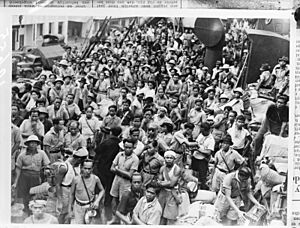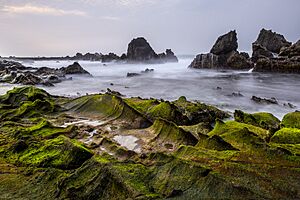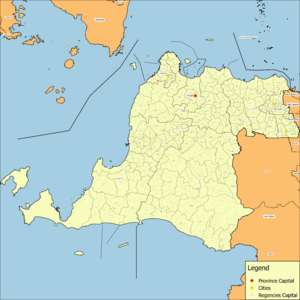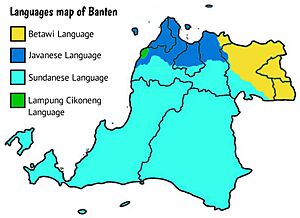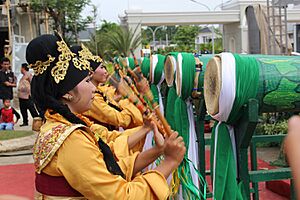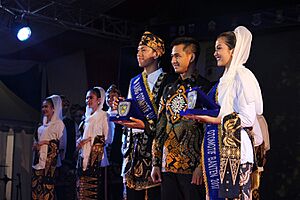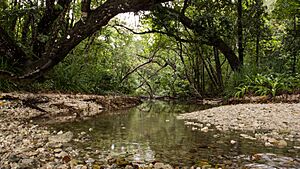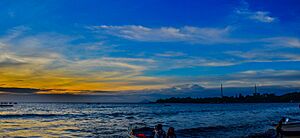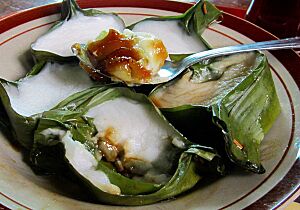Banten facts for kids
Quick facts for kids
Banten
|
||
|---|---|---|
| Province of Banten Provinsi Banten |
||
|
||
| Nickname(s): | ||
| Motto(s): | ||

|
||
|
OpenStreetMap
|
||
| Capital | Serang | |
| Largest city | Tangerang | |
| Established | 4 October 2000 | |
| Government | ||
| • Body | Banten Provincial Government | |
| Area | ||
| • Total | 9,352.77 km2 (3,611.12 sq mi) | |
| Area rank | 34th in Indonesia | |
| Highest elevation
(Mount Halimun)
|
1,929 m (6,329 ft) | |
| Population
(mid 2023 estimate)
|
||
| • Total | 12,307,732 | |
| • Rank | 5th in Indonesia | |
| • Density | 1,315.9451/km2 (3,408.2822/sq mi) | |
| Demonym(s) | Bantenese | |
| Demographics | ||
| • Religion | Islam (94.62%) Christianity (3.94%) —Protestant (2.65%) —Catholic (1.29%) Buddhism (1.30%) Hindu (0.10%) Aliran Kepercayaan (0.03%) Konghucu (0.01%) |
|
| • Languages | Indonesian (official) Sundanese (lingua franca) Javanese (minor areas) Betawi |
|
| Time zone | UTC+7 (Indonesia Western Time) | |
| ISO 3166 code | ID-BT | |
| GDP (nominal) | 2022 | |
| - Total | Rp 747.3 trillion (8th) US$ 50.3 billion Int$ 157.0 billion (PPP) |
|
| - Per capita | Rp 61.00 million (15th) US$ 4,107 Int$ 12,817 (PPP) |
|
| - Growth | ||
| HDI | ||
Banten is a province located on the western tip of Java, Indonesia. Its capital city is Serang, and its largest city is Tangerang. Banten borders West Java and Special Capital Region of Jakarta to the east. The Java Sea is to its north, the Indian Ocean to its south, and the Sunda Strait to its west. This strait separates Java from the island of Sumatra.
The province covers an area of about 9,353 square kilometers. In 2023, its population was estimated to be over 12.3 million people. Banten used to be part of the West Java province. However, it became its own separate province on October 17, 2000.
The northern part of Banten, especially near Jakarta, has grown very fast. Many people have moved there, and cities have expanded. The southern part, facing the Indian Ocean, is more traditional. However, its population is also growing quickly.
Banten was once part of ancient kingdoms like Tarumanagara and the Sunda Kingdom. Islam began to spread here in the 15th century. By the late 16th century, the Banten Sultanate was formed, making Islam the main religion. European traders, like the Portuguese, British, and Dutch, arrived later. The Dutch East India Company (VOC) eventually took control. Banten became part of the Dutch East Indies in 1808. After World War II, Indonesia became independent, and Banten became a separate province in 2000.
Contents
What Does the Name "Banten" Mean?
The name "Banten" has a few interesting possible meanings.
"Struck Down by Diamonds"
One idea is that "Banten" comes from the Sundanese phrase katiban inten. This means "struck down by diamonds." It refers to the history of the Bantenese people. They were animists (believing in spirits) before they learned about Buddhism and Hinduism. When Islam came to Banten, many people accepted it. This change was like being "struck down by diamonds," meaning something very valuable and beautiful.
"Ring Covered with Diamonds"
Another story says that the Hindu god Batara Guru traveled from east to west. He arrived in Surasowan, which is now Serang. He sat on a special stone called watu gilang, which glowed. This stone was given to the king. The area around Surasowan was said to have a clear, star-like river. It was described as a ring covered with diamonds, or ban inten in Sundanese. This phrase might have changed into "Banten."
"Rebuttal" or River Name
Some people think "Banten" comes from the Indonesian word bantahan, which means "rebuttal" or "resistance." This is because the local people often resisted the Dutch colonial government.
However, the word "Banten" was used even before the Banten Sultanate was formed. It was the name of a river, Ci Banten. The high lands along this river were called Cibanten Girang, or "Upper Banten." This area has been settled since the 11th and 12th centuries.
Banten's Past: A Quick Look
Early Kingdoms and the Sultanate

In the 5th century, Banten was part of the Tarumanagara kingdom. Later, it became part of the Sunda Kingdom. Around 1225, a Chinese writer named Chou Ju-kua described Sunda as an important port. It was known for its high-quality pepper.
In 1527, Javanese Muslims, led by Sunan Gunungjati, took control of the port of Banten. They established the Banten Sultanate. This sultanate became a major trading port in Southeast Asia. The town of Banten was a busy place with a river flowing through it. It had a fortress and a large town square. The Great Mosque of Banten was also built there.
European Traders and Dutch Rule

When Europeans arrived, the Portuguese were already trading in Banten. The English and Dutch also set up trading posts. The Dutch eventually became the strongest traders. They defeated the Portuguese in 1601.
The Banten Sultanate grew quickly because of trade, especially in pepper. It became a place where many different ethnic groups lived. Under Sultan Ageng Tirtayasa, Banten had a strong navy. It traded with many countries, including Persia, India, China, and Japan.
However, the Dutch East India Company (VOC) wanted to control the trade. A power struggle happened between Sultan Ageng Tirtayasa and his son, Sultan Haji. The VOC supported Sultan Haji, leading to a civil war. Sultan Ageng was captured and imprisoned in 1683. The VOC's influence in Banten grew stronger after this.
In 1808, during the Napoleonic Wars, the Dutch Governor-General Herman Willem Daendels ordered the construction of the Great Post Road. He also wanted the Sultan of Banten to move his capital. When the Sultan refused, Daendels attacked Banten and took control. The Sultanate was officially ended in 1813 by the British. After the British left, Banten became a "residency" under Dutch rule for many years.
Japanese Occupation and Independence
In March 1942, Japan invaded and occupied Banten during World War II. They built a railway to transport coal. This project used many forced laborers, and conditions were very difficult. Many people died during this time.
After Japan surrendered in August 1945, Indonesia declared its independence. The Dutch tried to regain control, leading to a war. Banten remained under Indonesian control. After the war, Banten became part of the West Java province. However, people in Banten wanted their own province. So, in 2000, Banten became a separate province of Indonesia.
Banten's Land and Weather
Where is Banten?
Banten is located between 5° and 7° south latitude and 105° and 106° east longitude. It covers an area of about 9,353 square kilometers.
Banten is very important because it is near the Sunda Strait. This strait is a busy sea lane that connects Australia and New Zealand with Southeast Asia. Banten also links the islands of Java and Sumatra. The province has many industries and seaports. These ports help handle cargo that might overflow from Jakarta's port.
Banten has many islands off its coast. There are about 81 named islands. Most of them are in Pandeglang Regency.
Land Features
The land in Banten ranges from sea level up to 2,000 meters high. Most of Banten is lowland, meaning it's less than 50 meters above sea level. This includes areas like Cilegon, Tangerang, and most of Serang Regency.
There are also sloping hills, especially in central Lebak Regency and Pandeglang Regency. Some areas, like eastern Lebak Regency, have steep hills and mountains. The highest point is Mount Halimun.
Climate and Rainfall
Banten's weather is affected by the monsoons from South and East Asia. During the rainy season, from September to May, strong west winds bring a lot of rain. The heaviest rainfall can be found in western Pandeglang Regency.
During the dry season, from April to December, east winds bring less rain. This can cause severe droughts, especially on the northern coast. Temperatures along the coast and in the hills are usually between 22°C and 32°C. In the mountains, temperatures are cooler, ranging from 18°C to 29°C.
People and Culture of Banten
Who Lives in Banten?
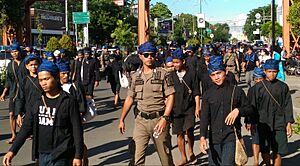
In 2022, Banten had over 12.2 million people. It is the fifth most populated province in Indonesia.
The Bantenese people are the largest group, making up about 47% of the population. They mostly live in the central and southern parts of the province. The Bantenese are closely related to the Banten Sultanate. They are a subgroup of the Sundanese people.
Other groups include the Javanese people, many of whom moved from central and eastern Java. The Betawi people live in the greater Jakarta area, including Tangerang. You can also find Chinese Indonesians in cities. A special group called the Benteng Chinese lives in Tangerang.
What Languages are Spoken?
The main language in Banten is Sundanese. The local people speak an older form of Sundanese. In the mountains and most of Banten, a "loma" (informal) version of Sundanese is common. The Bantenese language is spoken a lot, especially in southern Pandeglang Regency and Lebak Regency.
Near Serang and Cilegon, some people speak the Javanese Banyumasan dialect. In northern Tangerang, the Betawi language is spoken by people who moved from Jakarta. Of course, Indonesian is also widely spoken, especially in cities. The Baduy people speak their own language, which is also an old form of Sundanese.
Religions in Banten
Most people in Banten are Muslims, making up about 94.85% of the population. The Banten Sultanate was one of the biggest Islamic kingdoms on Java.
Banten also has people of other faiths. This includes the Benteng Chinese community in Tangerang, who are often Christian or Buddhist. The Baduy people practice their traditional religion called Sunda Wiwitan.
Long ago, Banten was influenced by Hindu and Buddhist kingdoms. Later, Islamic scholars like Sunan Gunungjati and Maulana Hasanuddin helped spread Islam throughout the region.
Banten's Unique Culture
Banten's culture is a mix of Hindu, Buddhist, and Islamic influences. It has many interesting traditions.
Traditional Arts
Banten is known for its pencak silat martial arts. The Saman dance and Palingtung are also popular. Important religious sites include the Great Mosque of Banten.
The Baduy people live in central and southern Banten. They are native Sundanese people who live a very traditional life. The Inner Baduy tribes avoid modern things, while the Outer Baduy tribes are a bit more open. Their villages are usually found along the Ciujung River.
Traditional Weapons
The golok is Banten's traditional weapon. It looks like a machete. In the past, it was used for self-defense. Today, it is often used in martial arts. The Baduy people use goloks for farming and hunting. Other traditional weapons include the kujang, kris, and spear.
Traditional Homes
Traditional houses in Banten have roofs made of thatch. Their floors are made from split and flattened bamboo. You can still see these types of houses in areas where the Kanekes and Baduy people live.
Traditional Clothing
Bantenese men traditionally wear shirts with closed necks and trousers. They often have a batik belt, and sometimes a golok tucked into it. Bantenese women traditionally wear a kebaya (a traditional blouse). They decorate it with a brooch at the waist. Their hair is usually tied in a bun and decorated with a flower.
Pencak Silat: A Martial Art
Pencak silat is a group of martial arts that comes from Indonesian culture. It has existed for a very long time. When Islam spread in the 15th century, martial arts were taught alongside religious studies in Islamic boarding schools. This made religion and pencak silat closely connected. Silat also helped people defend their region from invaders.
Banten is famous for its skilled warriors who are good at martial arts. Debus is a special Bantenese martial art that developed in the 16th century.
Getting Around Banten
Banten is located in western Java. Its roads are important for connecting different areas. Some roads are in good condition, while others need repair. National roads can get very busy.
Train travel is also available, but not all railway lines are used. The main line connects Merak to Tanah Abang. There are also lines for freight and the Soekarno–Hatta Airport Rail Link to Soekarno–Hatta International Airport.
Soekarno–Hatta International Airport is Indonesia's main airport. It is located in Tangerang, Banten. Other airports in the province are used for general aviation, training, or by the military.
Banten's Economy
Banten GDP share by sector (2022) Agriculture (5.09%) Manufacturing (30.47%) Service (49.86%)
Banten's economy is strong. In 2005, a big part of its economy came from manufacturing (almost 50%). Other important sectors were trade, hotels, and restaurants. Transportation, communication, and agriculture also played a role.
Many jobs are in manufacturing, agriculture, and trade. The northern part of Banten is more developed economically than the southern part. This is because the north has better infrastructure and is close to Jakarta.
Fun Things to See and Do
Nature and Parks
Ujung Kulon National Park is a famous national park and nature preserve. It includes the island of Panaitan. This park protects many animals, like the Javan rhino, deer, and wild boar. You can reach it by boat or from Labuan. The park has facilities like electricity, clean water, and guides. In 1991, it became a UNESCO World Heritage Site.
Pulau Dua, near Serang, is known for its ocean coral, fish, and birds. Between April and August, about 40,000 birds from 60 different species visit this area.
Tanjung Lesung Beach is in western Pandeglang Regency. It is a large area of about 150 hectares. It became a special economic zone in 2015, which means it's a place where tourism is encouraged to grow.
BXSea Bintaro Jaya is a very large aquarium in South Tangerang City. It is one of the biggest aquariums and tourist attractions in Southeast Asia. It opened in December 2023.
Food to Try
Rabeg is a traditional Bantenese food. It is similar to goat stew or curry. It is believed to have come from the Arabian Peninsula. Other tasty Bantenese foods include nasi sumsum (rice with buffalo-bone marrow), milkfish and duck satays, and laksa Tangerang.
Sports in Banten
Football
Banten has several football clubs. Two of them, Persita Tangerang and Dewa United, play in Indonesia's top league, Liga 1. They both play at the Indomilk Arena in Tangerang Regency. Other clubs play in lower leagues, like Persikota Tangerang, Persic Cilegon, and Perserang Serang.
Motorsports
In 2009, the Lippo Village International Formula Circuit was built in Banten. It was hoped to host a big international race. While that didn't happen, the track was used for local races. Later, it was taken down for other development. A new street circuit, BSD City Grand Prix, was built in BSD City for local motorsports events.
Images for kids
-
With his father, Sunan Gunungjati, Sultan Maulana Hasanuddin founded the Sultanate of Banten.
-
The Port of Merak has ferry service to Sumatra.
-
Soekarno–Hatta International Airport in Tangerang, gateway to Jakarta and Indonesia.
-
KRL Commuterline train at the Tangerang railway station.
See also
 In Spanish: Provincia de Bantén para niños
In Spanish: Provincia de Bantén para niños



